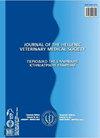饲粮低钙低磷对肉仔鸡生长性能和骨骼Mineralizatıon的影响
IF 0.4
4区 农林科学
Q4 VETERINARY SCIENCES
引用次数: 0
摘要
本试验旨在研究以2:1比例降低饲粮钙(Ca)和非植酸磷(NPP)水平对Ross-308肉仔鸡生产性能、胴体参数和骨矿化的影响。试验选用11400只1日龄雏鸡,随机分为5个饲粮处理,共12个重复,分别饲喂推荐(对照处理,T1)和低6.25% Ca和NPP水平的饲粮。SP后,对照处理(T1)继续在生长期和育肥期分别饲喂钙含量为0.87和0.78%的饲粮,而6.25%还原组根据钙和NPP水平的降低程度分为4个饲粮处理,在生长期和育肥期分别饲喂钙含量为0.79、0.65 (T2)、0.79、0.60 (T3)、0.75、0.65 (T4)和0.75、0.60 (T5) %的饲粮。SP后,适度甚至大幅度降低Ca和NPP显著降低采食量(FI)(二次曲线,P>0.05),但获得与对照组相近的增重(BWG)和FCR (P>0.05)。另一方面,在T1 ~ T5期间,饲粮钙含量降低显著降低了肉仔鸡总钙摄入量和NPP摄入量(p < 0.01),且钙摄入量与肉重比和体重增重分别呈极显著的线性和二次关系。综上所述,在不影响现代肉鸡生长性能和骨矿化的情况下,将生长和育肥期钙水平分别降低至0.75和0.60%是可能的。本文章由计算机程序翻译,如有差异,请以英文原文为准。
Effects of Lower Dietary Calcium and Phosphorus on Growth Performance and Bone Mineralizatıon of Broilers
This experiment was carried out to investigate the effects of reduced dietary calcium (Ca) and non-phytate-phosphorus (NPP) levels at 2:1 constant ratio on performance, carcase parameters and bone mineralization of Ross-308 broilers. A total of 11400 one-day-old chicks were randomly allocated to five dietary treatments with twelve replicates and were fed starter diets including either recommended (control treatment, T1) or a 6.25% lower level of both Ca and NPP according to breeder’s recommendations during starter period (SP). After SP, control treatment (T1) continued to be provided through diets containing 0.87 and 0.78 % Ca for grower (GP) and finisher periods (FP), respectively, while 6.25 % reduced group was divided into 4 dietary treatments regarding extent of decrease in Ca and NPP levels and provided by diets containing 0.79;0.65 (T2), 0.79;0.60 (T3), 0.75;0.65 (T4), and 0.75;0.60 (T5) % Ca for GP and FP, respectively. After SP, moderate and even substantial reduction of Ca and NPP significantly decreased feed intake (FI) (quadratic, P<0.05), but obtained similar body weight gain (BWG) and FCR compared to the control (P>0.05). On the other hand, reduced dietary Ca through T1 to T5 significantly decreased the total Ca and NPP intake of broilers (linear and quadratic, P<0.01), and accompanied to significant linear and quadratic relationship between Ca intake and FCR and BWG respectively. It can be concluded that reducing Ca level down to 0.75 and 0.60 % in grower and finisher phase, respectively are possible without compromising the growth performance and bone mineralization of modern broilers.
求助全文
通过发布文献求助,成功后即可免费获取论文全文。
去求助
来源期刊

Journal of the Hellenic Veterinary Medical Society
VETERINARY SCIENCES-
CiteScore
0.60
自引率
0.00%
发文量
83
审稿时长
>12 weeks
期刊介绍:
The Journal of the Hellenic Veterinary Medical Society (J Hellenic Vet Med Soc) is a quarterly peer-reviewed journal that publishes articles in all aspects of veterinary science and related disciplines. It is published by the Hellenic Veterinary Medical Society and is indexed in the Web of Science and in Scopus.
There are no publication fees in the journal. Authors considering submitting manuscripts for evaluation and publication are requested to read carefully the instructions for authors and fully comply with them.
Non-complying manuscripts may be returned to the corresponding author for formatting.
 求助内容:
求助内容: 应助结果提醒方式:
应助结果提醒方式:


